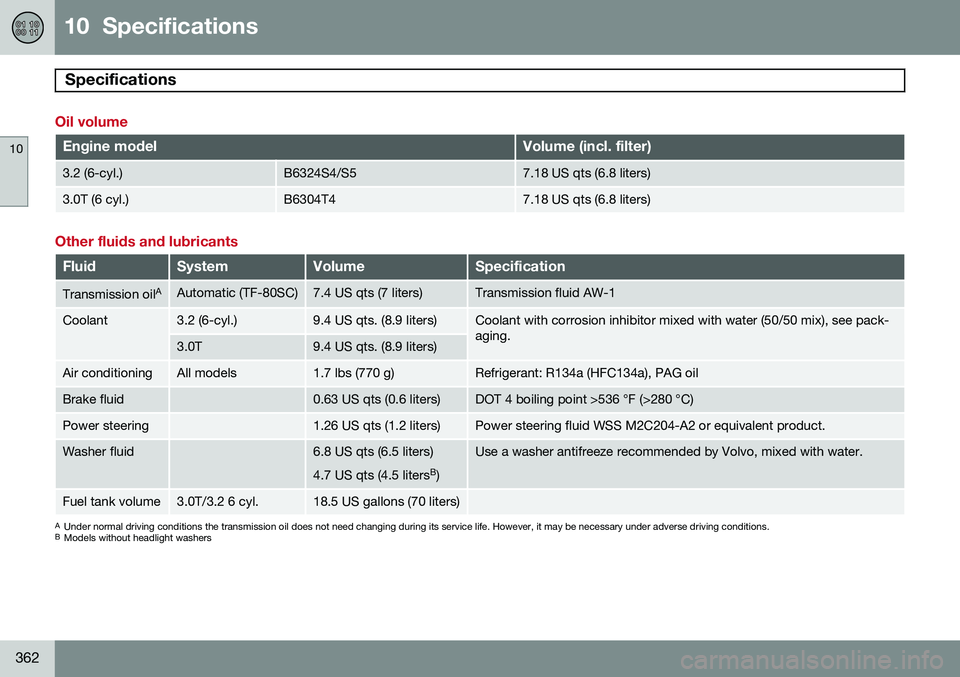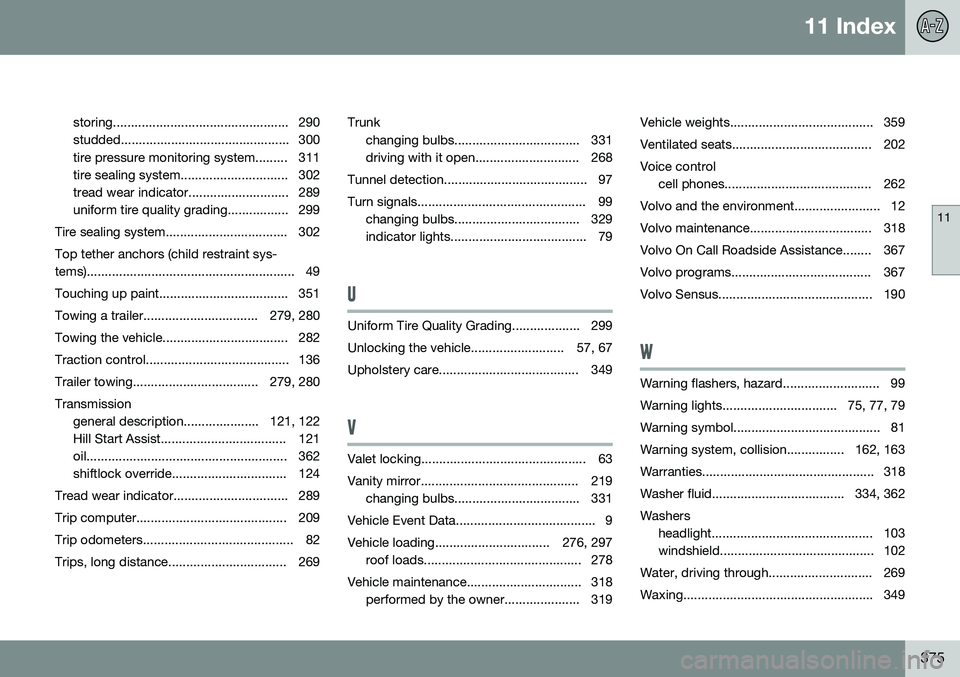2014 VOLVO S80 transmission fluid
[x] Cancel search: transmission fluidPage 119 of 380

03 Your driving environment
Starting the engine
03
117
WARNING
•Always remove the remote key from the ignition slot when leaving the vehi-cle and ensure that the ignition inmode
0 (see page 85 for information
about the ignition modes), especially ifthere are children in the vehicle.
• On vehicles with the optional keylessdrive, never remove the remote keyfrom the vehicle while it is being drivenor towed.
• Always place the gear selector in Parkand apply the parking brake beforeleaving the vehicle. Never leave thevehicle unattended with the enginerunning.
• Always open garage doors fully beforestarting the engine inside a garage toensure adequate ventilation. Theexhaust gases contain carbon monox-ide, which is invisible and odorless butvery poisonous.
NOTE
•After a cold start, idle speed may be noticeably higher than normal for ashort period. This is done to help bringcomponents in the emission controlsystem to their normal operating tem-perature as quickly as possible, whichenables them to control emissions andhelp reduce the vehicle's impact on the environment 3
.
CAUTION
• When starting in cold weather, the automatic transmission may shift up atslightly higher engine speeds than nor-mal until the automatic transmissionfluid reaches normal operating tem-perature.
• Do not race a cold engine immediatelyafter starting. Oil flow may not reachsome lubrication points fast enough toprevent engine damage.
• The engine should be idling when youmove the gear selector. Never acceler-ate until after you feel the transmissionengage. Accelerating immediately afterselecting a gear will cause harshengagement and premature transmis-sion wear.
• Selecting
P or N when idling at a
standstill for prolonged periods of timewill help prevent overheating of theautomatic transmission fluid.
3 If the gear selector is in the D or R positions and the car is not moving, engine speed (rpm) will be lower and it will take longer for the engine to reach normal operating temperature.
Page 272 of 380

07 During your trip
Driving recommendations
07
270
Before a long distance tripIt is always worthwhile to have your vehicle checked by a trained and qualified Volvoservice technician before driving long dis-tances. Your retailer will also be able to sup-ply you with bulbs, fuses, spark plugs andwiper blades for your use in the event thatproblems occur. As a minimum, the following items should be checked before any long trip:• Check that engine runs smoothly and that fuel consumption is normal.
• Check for fuel, oil, and fluid leakage
• Have the transmission oil level checked.
• Check condition of drive belts.
• Check state of the battery's charge.
• Examine tires carefully (the spare tire aswell), and replace those that are worn.Check tire pressures.
• The brakes, front wheel alignment, andsteering gear should be checked by atrained and qualified Volvo service techni-cian only.
• Check all lights, including high beams.
• Reflective warning triangles are legallyrequired in some states/provinces.
• Have a word with a trained and qualifiedVolvo service technician if you intend to drive in countries where it may be difficultto obtain the correct fuel.
• Consider your destination. If you will bedriving through an area where snow or iceare likely to occur, consider snow tires.
Cold weather precautionsIf you wish to check your vehicle before the approach of cold weather, the followingadvice is worth noting:
• Make sure that the engine coolant con- tains 50 percent antifreeze. Any othermixture will reduce freeze protection. Thisgives protection against freezing down to–31 °F (–35 °C). The use of "recycled"antifreeze is not approved by Volvo. Dif-ferent types of antifreeze must not bemixed.
• Volvo recommends using only genuineVolvo antifreeze in your vehicle's radiator.
• Try to keep the fuel tank well filled – thishelps prevent the formation of condensa-tion in the tank. In addition, in extremelycold weather conditions it is worthwhileto add fuel line de-icer before refueling.
• The viscosity of the engine oil is impor-tant. Oil with low viscosity (thinner oil)improves cold-weather starting as well asdecreasing fuel consumption while theengine is warming up. Full synthetic0W-30 oil is recommended for driving inareas with sustained low temperatures. •
The load placed on the battery is greaterduring the winter since the windshieldwipers, lighting, etc., are used moreoften. Moreover, the capacity of the bat-tery decreases as the temperature drops.In very cold weather, a poorly chargedbattery can freeze and be damaged. It istherefore advisable to check the state ofcharge more frequently and spray an anti-rust oil on the battery posts.
• Volvo recommends the use of snow tireson all four wheels for winter driving, seepage 300.
• To prevent the washer fluid reservoir fromfreezing, add washer solvents containingantifreeze. This is important since dirt isoften splashed on the windshield duringwinter driving, requiring the frequent useof the washers and wipers. Volvo WasherSolvent should be diluted as follows:Down to 14 °F (–10 °C): 1 part washersolvent and 4 parts water Down to 5 °F(–15 °C): 1 part washer solvent and3 parts water Down to 0 °F (–18 °C):1 part washer solvent and 2 parts waterDown to –18 °F (–28 °C): 1 part washersolvent and 1 part water.
• Use Volvo Teflon Lock Spray in the locks.
• Avoid using de-icing sprays as they cancause damage to the locks.
Page 364 of 380

10 Specifications
Specifications
10
362
Oil volume
Engine modelVolume (incl. filter)
3.2 (6-cyl.)B6324S4/S57.18 US qts (6.8 liters)
3.0T (6 cyl.)B6304T47.18 US qts (6.8 liters)
Other fluids and lubricants
FluidSystemVolumeSpecification
Transmission oilAAutomatic (TF-80SC)7.4 US qts (7 liters)Transmission fluid AW-1
Coolant3.2 (6-cyl.)9.4 US qts. (8.9 liters)Coolant with corrosion inhibitor mixed with water (50/50 mix), see pack- aging.
3.0T9.4 US qts. (8.9 liters)
Air conditioningAll models1.7 lbs (770 g)Refrigerant: R134a (HFC134a), PAG oil
Brake fluid0.63 US qts (0.6 liters)DOT 4 boiling point >536 °F (>280 °C)
Power steering1.26 US qts (1.2 liters)Power steering fluid WSS M2C204-A2 or equivalent product.
Washer fluid6.8 US qts (6.5 liters) 4.7 US qts (4.5 liters B
)Use a washer antifreeze recommended by Volvo, mixed with water.
Fuel tank volume3.0T/3.2 6 cyl.18.5 US gallons (70 liters)
A Under normal driving conditions the transmission oil does not need changing during its service life. However, it may be necessary under adverse driving conditions.
B Models without headlight washers
Page 370 of 380

11 Index
11
368
1, 2, 3 ...
12-volt sockets........................................ 219
A
ABS (anti-lock brake system).................. 128
Accessory installation warning.................. 13
Active chassis system............................. 216
Active high beams..................................... 95Active yaw control................................... 136
Adaptive brake lights............................... 127
Adaptive cruise control.................... 142, 144 queue assist........................................ 147
Airbags disconnecting the front passenger’s
side................................................. 26, 27
front...................................................... 22
inflatable curtain................................... 32
side impact........................................... 30
Air conditioning........................................ 204
Air distribution.......................................... 200
Air distribution table................................. 207
Air vents................................................... 201 All Wheel Drive......................................... 124
Ambient temperature sensor..................... 82
Anti-freeze....................................... 270, 324Anti-lock brake system
warning light................................... 77, 79
Anti-lock Brake System (ABS)................. 128
Approach lighting.............................. 57, 101Audio system AUX/USB sockets............................... 248 Bluetooth ®
devices............................. 251
Bluetooth ®
hands-free system........... 253
Bluetooth streaming audio................. 251
getting started.................................... 225
HD digital radio................................... 236
introduction......................................... 224
media player....................................... 243
overview.............................................. 224
radio functions.................................... 234SiriusXM ™ satellite radio.................... 238
sound settings.................................... 229
steering wheel keypad........................ 225
voice control....................................... 262
Auto-dim rearview mirror......................... 107
Automatic locking retractor....................... 38 Automatic transmission
Geartronic........................................... 122
general description..................... 121, 122
oil........................................................ 362
shiftlock override................................ 124
Axle weight.............................................. 297
B
Battery changing..................................... 336, 337
maintenance....................................... 336
remote key, replacing........................... 61
specifications...................................... 363
warning symbols................................. 335
Blind Spot Information System (BLIS) 184, 185, 186
Bluetooth cell phone connection............. 253
Booster cushions....................................... 46
Brake lights.............................................. 127Brake system ABS..................................................... 128
Brake pad inspection.......................... 127
checking fluid level............................. 324
emergency brake assistance.............. 128
fluid..................................................... 362
general information............................. 127
Page 372 of 380

11 Index
11
370
E
ECC......................................... 202, 204, 206
Eco guide................................................. 125
Economical driving.................................. 268
Electrically heated steering wheel............. 93
Electric parking brake.............................. 130
Electronic Climate Control....... 202, 204, 206air distribution table............................ 207
Interior Air Quality System.................. 206
ventilated seats................................... 202
Emergency locking retractor...................... 38
Emergency starting.................................. 119
Emergency towing................................... 282
Emission inspection readiness................ 319Engine overheating........................................... 80
specifications...................................... 360
starting................................................ 116
switching off....................................... 119
Engine compartment overview................ 321
Engine oil................................................. 361 checking............................................. 322
low pressure warning light.................... 79
volumes.............................................. 362 Engine remote start (ERS)........................ 118
Environment............................................... 12
Eyelets for anchoring loads..................... 276
F
Federal Clean Air Act............................... 318 Flat tires
repairing with tire sealing system....... 302
Floor mats cleaning.............................................. 351
placing correctly................................. 116
Fluid specifications.................................. 362
Fog lights................................................... 79 rear........................................................ 98
Four C (active chassis system)................ 216
Front airbags.............................................. 22 disconnecting passenger’s side air-
bag.................................................. 26, 27
Front park assist.............................. 176, 178
Front seats........................................... 86, 88 heated................................................. 202
Fuel filler cap........................................... 274
Fuel filler door, opening........................... 273 Fuel level warning light.............................. 79
Fuel requirements............................ 271, 272
Fuel tank volume..................................... 362
Fuses....................... 339, 340, 343, 346, 347G
Garage door opener
HomeLink ®
Wireless Control System. 113
Gasoline requirements............................. 272
Gas tank volume...................................... 362
Gauges...................................................... 75
Geartronic................................................ 122
Geartronic automatic transmission.......... 122
Generator warning light............................. 80
Glossary of tire terminology..................... 296
Grocery bag holder.................................. 277
Gross vehicle weight............................... 297
H
Hazard warning flashers............................ 99
HD digital radio........................................ 236
Page 377 of 380

11 Index
11
375
storing................................................. 290
studded............................................... 300
tire pressure monitoring system......... 311
tire sealing system.............................. 302
tread wear indicator............................ 289
uniform tire quality grading................. 299
Tire sealing system.................................. 302 Top tether anchors (child restraint sys-
tems).......................................................... 49
Touching up paint.................................... 351
Towing a trailer................................ 279, 280
Towing the vehicle................................... 282
Traction control........................................ 136
Trailer towing................................... 279, 280Transmission general description..................... 121, 122
Hill Start Assist................................... 121
oil........................................................ 362
shiftlock override................................ 124
Tread wear indicator................................ 289
Trip computer.......................................... 209
Trip odometers.......................................... 82
Trips, long distance................................. 269 Trunk
changing bulbs................................... 331
driving with it open............................. 268
Tunnel detection........................................ 97
Turn signals............................................... 99 changing bulbs................................... 329
indicator lights...................................... 79
U
Uniform Tire Quality Grading................... 299
Unlocking the vehicle.......................... 57, 67
Upholstery care....................................... 349
V
Valet locking.............................................. 63
Vanity mirror............................................ 219
changing bulbs................................... 331
Vehicle Event Data....................................... 9
Vehicle loading................................ 276, 297 roof loads............................................ 278
Vehicle maintenance................................ 318 performed by the owner..................... 319 Vehicle weights........................................ 359
Ventilated seats....................................... 202Voice control
cell phones......................................... 262
Volvo and the environment........................ 12
Volvo maintenance.................................. 318
Volvo On Call Roadside Assistance........ 367
Volvo programs....................................... 367
Volvo Sensus........................................... 190
W
Warning flashers, hazard........................... 99
Warning lights................................ 75, 77, 79
Warning symbol......................................... 81
Warning system, collision................ 162, 163
Warranties................................................ 318
Washer fluid..................................... 334, 362Washers headlight............................................. 103
windshield........................................... 102
Water, driving through............................. 269
Waxing..................................................... 349